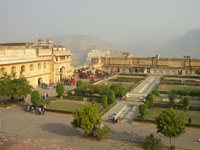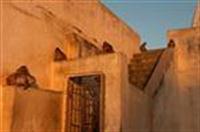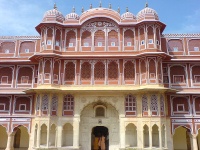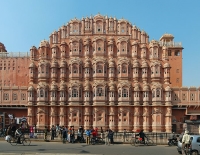
Situated on the crest of a hill seven miles (11km) north of Jaipur is Amber, capital of the Kuchwaha Rajputs from 1037 to 1728. The city-palace is protected by towering outer walls, and a further wall runs for miles along the hills surrounding the palace. For many, the most memorable part of a trip to Jaipur is the journey up the palace ramparts, through a succession of vast gates, on the back of a painted elephant, Maharaja-style. Inside are the ruins of a once-great palace: a wonderful example of Rajput architecture, with Mogul influences. Visitors will be able to see the remains of the Maharajas quarters surrounded by the rooms of his many wives and concubines, each linked to his bedroom by secret steps and passageways to avoid jealousy. Although much of the complex is closed to the public, there is still a large area to explore. Visitors are advised to spend at least a few hours here, and ideally to hire a guide who will explain the architecture and history of the palace. Don't forget to pack your camera. Photo opportunities abound at Amber Palace but note that there is a small additional fee for those who want to take photographs.
Address : Devisinghpura, Amer, Jaipur
Website : www.amberfort.org/

Situated between two granite cliffs, this temple is part of a much larger temple complex. The complex has three sacred pools which locals, and the monkeys, enjoy swimming in. This Hindi temple is slightly dilapidated but definitely still worth the trip out of the city - the views of Jaipur afforded from its vantage are simply unforgettable. The best time to see the temple is at sunset, when the monkeys appear for their evening swim and when the light is stunning for photographs. The complex is covered in monkeys and some other animals and it is not a polished, elegant place, but it is interesting and in its own way very beautiful. There may be mud and beggars and livestock in the mix with the crumbling beauty and sacred pools but for many this only adds authenticity and interest. The monkeys are tame and usually keen to interact with people - those who don't like animals should steer clear. They are not dangerous and tend to be quite gentle; many visitors bring along food for them. The temple is active and a good place to witness Indian worship and people-watch.
Address : Outside Gulta Pol, close to Agra Road. Follow the steps from the Sun Temple down the hill to find Galtaji
Website : www.jaipur-travel-guide.com/Jaipur-attractions/Galta-Ji-Jaipur-monkey-temple.html

The magnificent City Palace is in the centre of the Pink City of Jaipur, enclosed by high walls and set amid fine gardens and courtyards. Since Jai Singh built it in 1728, it has been the principal residence for the Maharajas of Jaipur and successive rulers have each added to it. The palace was built during the glory days and the exhibits and interior have lost none of their splendour: the doors and gateways preserve their flamboyant decoration; and royal retainers, clothed in turbans and full livery, still guard the principal halls and entrances.Chandra Mahal is the private palace of the current ruler and is approached through a number of courtyards. Mubarak Mahal, in the first courtyard, was once a guesthouse and is now a textile museum. There are a number of other museums displaying old costumes and uniforms, carpets, mementos, elephant saddles and an armoury containing a fascinating array of fearsome and inventive weapons dating back to the Mogul era.A beautifully-carved marble gate with brass doors leads to the second courtyard, where Diwan-I-Khas, the hall of private audiences, is found. On display here are two gigantic silver urns used by Madho Singh II to carry water from the holy Ganges with him when he travelled to London in 1902 on board an ocean liner - he was reluctant to trust the water in the West! These are said to be the largest silver vessels in the world - 243kg of silver was required to cast each urn, and they can hold 8,182 gallons of water.
Address : Chokri Shahad, Old City
Website : www.royaljaipur.in/

The Palace of the Winds is Jaipur's most acclaimed attraction. Built in 1799, it is situated on the edge of the City Palace complex overlooking one of the city's bustling main streets, and was constructed to offer the women of the court a vantage point, behind stone-carved screens, from which to watch the activity in the bazaars below. The five-storey building is shaped like a crown adorning Lord Krishna's head, and contains over five hundred finely-screened windows and balconies. Although the palace's primary appeal is its ornate and finely-carved pink façade, visitors can also go inside and see the intricate, honeycombed stonework of the original screens close up. There are beautiful views of the city and some surrounding forts from the inside of the building. Additional motivation for exploring the interior - apart from the thrill of imagining the royal wives and consorts flitting about behind their screens - is the naturally cool, breezy nature of the place, which makes it refreshing on hot days. Those who just want to see the building and take some photos can do so from the road without paying the entrance fee. The building is particularly lovely early in the morning when the light makes it seem even pinker than usual.
Address : Hawa Mahal Rd, Badi Choupad, J.D.A. Market, Pink City, Jaipur
Website : www.hawa-mahal.com/

Travel Guide powered by Word Travels, copyright © 2023 Globe Media Ltd. By its very nature information in this travel guide is subject to change at short notice and travellers are urged to verify information on which they're relying with the relevant authorities. Neither Globe Media Ltd nor Travel Vogue can accept any responsibility for any loss or inconvenience to any person as a result of information contained above.